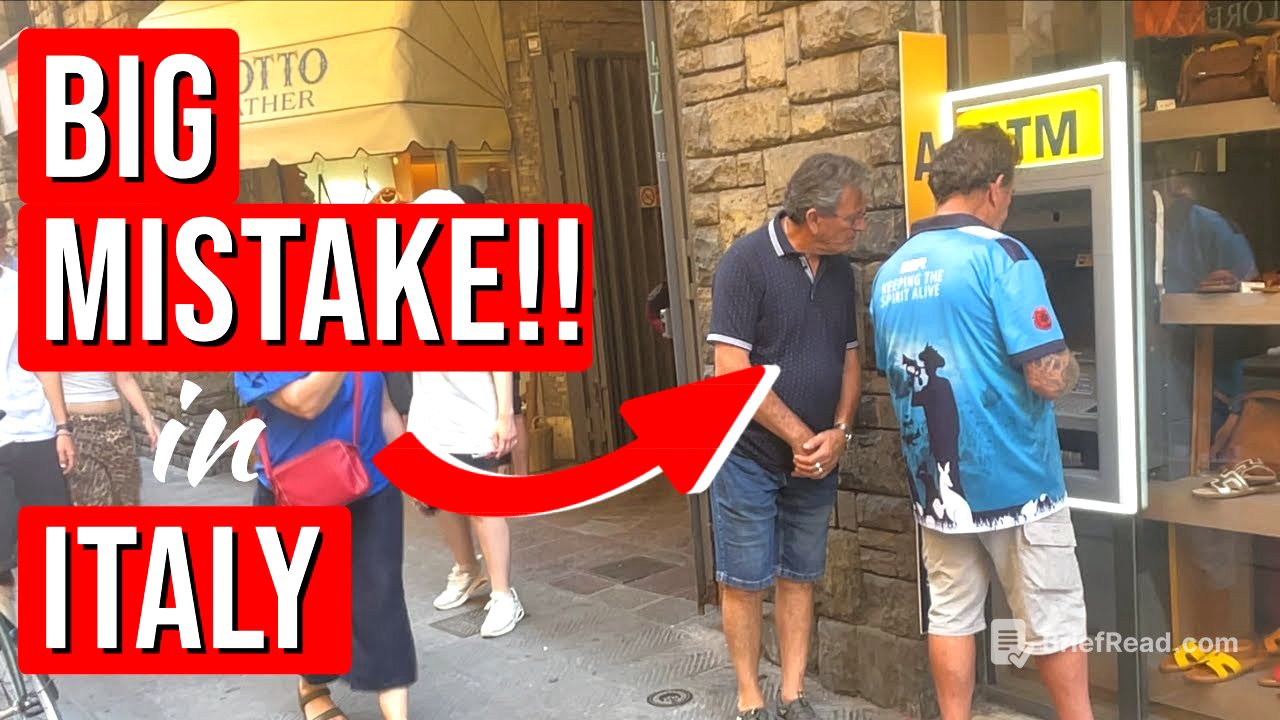TLDR;
This video outlines ten common money-wasting mistakes tourists make in Italy and provides practical tips to avoid them. These include overlooking trip insurance, not planning phone usage, using the wrong credit cards, choosing the wrong currency exchange venues, failing to book train tickets in advance, dining at tourist traps, over-tipping, ignoring street food, falling for scams, and purchasing fake leather goods. By being informed and proactive, travelers can save money and enhance their Italian experience.
- Buy trip insurance to cover medical emergencies, trip interruptions, and lost luggage.
- Plan your phone usage to avoid high roaming charges.
- Use credit cards with no foreign transaction fees and always pay in local currency.
- Exchange currency at bank ATMs (bankomats) for the best rates.
- Book high-speed train tickets in advance to save money.
- Avoid tourist trap restaurants by looking for local spots.
- Understand Italian tipping culture to avoid over-tipping.
- Enjoy street food for affordable and authentic meals.
- Be aware of common scams, such as taxi scams and unsolicited gifts.
- Purchase leather goods from reputable vendors and look for "Made in Italy" or "Vera Pelle" labels.
Not Buying Trip Insurance [0:26]
Trip insurance is essential for travelers as a safety net, covering lost luggage, trip interruptions, cancellations, emergency medical care, and evacuation. US health insurance, including Medicare, typically doesn't cover medical expenses in Italy. Credit card coverage may have limitations and require extensive paperwork for reimbursement. Websites like insuremytrip.com offer various coverage options, with medical care and evacuation being top priorities. Purchasing trip insurance within 10 days of the first booking can cover pre-existing conditions. Annual plans like Medjet Assist for evacuation and Travel Guard for medical expenses are also viable options.
Not Setting Up a Phone Plan [4:17]
Failing to plan for phone usage in Italy can lead to high charges for texts, calls, and data. T-Mobile may offer international coverage, but Verizon and AT&T require an international plan, costing around $10 a day. Without a plan, charges can be exorbitant, such as $2 per minute for calls and over $2,000 per gigabyte of data. A cost-effective alternative is to get a SIM card in Italy, but the phone must be unlocked.
Using the Wrong Credit and Debit Cards [5:57]
Using credit cards with foreign transaction fees can add up to 3% to each transaction. It's advisable to get a no-fee credit card, such as the Chase Sapphire Preferred Card or Capital One Venture Rewards Card, which also offer signup bonuses and points. When paying with a credit card, always choose to pay in the local currency (Euro) for a better exchange rate.
Choosing the Wrong Place to Get Euros [7:46]
While credit cards are widely accepted, carrying some cash is necessary for small expenses. Avoid non-bank ATMs and currency exchange booths, which offer unfavorable exchange rates and high fees. Getting Euros from your bank at home is a marginally okay option. The best way to exchange money is at a bank ATM (bankomat) for the best exchange rate and lowest fees. Use a debit or cash card with no foreign transaction fees, such as those from Charles Schwab or Fidelity, specifying payment in euros during the transaction.
Not Booking Trains Well in Advance [10:51]
Booking train tickets, especially for high-speed trains like the Freccia Rossa, well in advance can save significant money. Prices increase closer to the travel date. For example, a ticket from Florence to Rome might cost €100 if bought the day before, but only €50 if bought three months in advance.
Eating in Tourist Trap Restaurants [12:08]
Tourist trap restaurants offer mediocre food at inflated prices and may not serve authentic Italian dishes. These restaurants are often located near major tourist attractions, have menus in multiple languages with pictures, and have waiters beckoning customers. Eat where the locals do for authentic recipes at reasonable prices. Look for menus in Italian or Italian and English, handwritten menus, and recommendations from locals. Check reviews on TripAdvisor and Google, filtering for Italian reviews to gauge local opinions on the food. Making reservations, especially on weekends, is recommended.
Tipping Like You're in the United States [15:50]
Tipping culture in Italy differs from the United States. Italians typically tip very little, if at all, as servers are salaried employees. Rounding up the bill or leaving a few coins for good service is sufficient. Be aware of the "coperto" (cover charge) for table linens and bread, which is standard, and the "servizio" (service charge), which is a tip added to the bill in fancier restaurants. Taxi drivers do not expect a tip, but rounding up the fare is appreciated.
Not Experiencing Street Food [18:26]
Enjoying street food is a great way to save money and sample local cuisine, especially at lunchtime. Try supplì in Rome, triskata or lampredotto in Florence, scartosso de pese frito in Venice, and trionzini in Naples.
Falling for Scams [19:40]
Be aware of common scams, such as taxi drivers overcharging or claiming their credit card machine is broken. Always ensure you have small bills, count your change, and state your intention to pay by credit card before entering the taxi. Avoid drivers who solicit rides inside airports or train stations. Be cautious of people offering "gifts" like friendship bracelets, as they may demand payment or be pickpockets. Watch out for art displayed on the ground, as sellers may claim you damaged it and demand payment. Avoid signing petitions in high-traffic areas, as petitioners may be pickpockets or working with accomplices.
Buying Fake Leather Goods [24:10]
Genuine Italian leather is known for its quality, but many vendors sell inferior products as genuine leather, especially in open markets. Real Italian leather is not cheap. Look for labels such as "Made in Italy," indicating some production steps occurred in Italy, or "Vera Pelle," meaning true leather made according to specific standards.









